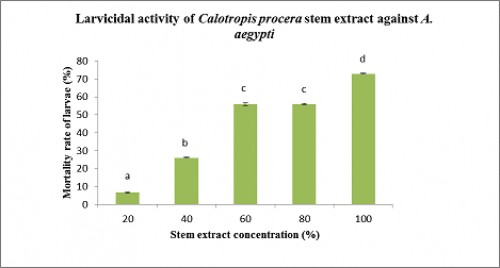Larvicidal potential of Calotropis procera against Aedes aegypti
Author(s): Aqsa Butt, Beenish Zia Butt and Seemal Ejaz Vehra
Abstract: The present study was conducted to know the larvicidal effects of native plant, Calotropis procera (Giant milkweed). Leaves and stem of the plant were used to check the larvicidal activity. Microwave assisted extraction was used for material extraction. Different concentrations (20%, 40%, 60%, 80% and 100%) of the leaf and stem extract were used. Mortality of the larvae was observed after twenty four hours. Results showed the effectively of higher concentrations was greater as compared to lower concentrations. Leaf extract was found to be more significant in killing the larvae while the stem extract showed less significant results. It is concluded that all parts of this plant can be used for the prevention and control of A. aegypti mosquitoes due to its pesticide properties and bioactive chemicals.
 Fig.:
Fig.: Effect of different concentrations of
Calotropis procera stem extract on the mortality rate of
Aedes Aegypti larvae
. Each value is a mean of three replicates with standard deviation. One way ANOVA with Duncan’s multiple test range is applied to compare means by using SPSS software.
How to cite this article:
Aqsa Butt, Beenish Zia Butt, Seemal Ejaz Vehra. Larvicidal potential of Calotropis procera against Aedes aegypti . Int J Mosq Res 2016;3(5):47-51.



